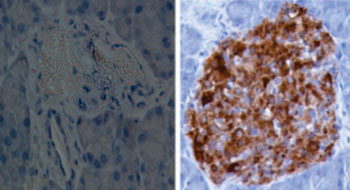Insufficient Interleukin-35 Leads to Type I Diabetes in Mouse Models
By LabMedica International staff writers
Posted on 11 Aug 2015
Diabetes researchers have linked onset of the disease to abnormally low levels of the anti-inflammatory cytokine interleukin-35 (IL-35), which is produced by regulatory T (Treg) cells to suppress autoimmune and inflammatory responses.Posted on 11 Aug 2015
Investigators at Uppsala University (Sweden) used two mouse models to study the role of IL-35 in Type I diabetes (Tid). The first model consisted of mice made diabetic by multiple injections of low doses of the drug streptozotocin (MLDSTZ mice), while the second consisted of mice from the non-obese diabetic mouse (NOD) line.

Image: A representative image of islets from diabetic mice, which did not receive IL-35 (left) and received IL-35 (right). The brown color represents insulin producing beta cells. New research showed progress in the use of the anti-inflammatory cytokine for treatment of Type I diabetes (Photo courtesy of Dr. Kailash Singh, Uppsala University).
The investigators studied the kinetics of Treg cell response in the MLDSTZ model and measured the levels of IL-35 in human T1D patients. They found that Treg cells were increased in MLDSTZ mice. However, the Treg cells showed a decreased production of anti-inflammatory cytokines (IL-10, IL-35, TGF-beta) and increased production of pro-inflammatory cytokines (IFN-gamma, IL-2, IL-17), indicating a phenotypic shift of Treg cells under T1D conditions.
Results published in the July 30, 2015, online edition of the journal Scientific Reports revealed that administration of IL-35 effectively prevented development of T1d in MLDSTZ mice and counteracted established T1D in this model, seemingly by induction of IL-35 production in Treg cells, thus reversing the phenotypic shift of the Treg cells. In addition, IL-35 administration reversed established hyperglycemia in the NOD mouse model of T1D. Moreover, circulating IL-35 levels were decreased in human T1D patients compared to healthy controls.
"To the best of our knowledge, we are the first to show that IL-35 can reverse established Type I diabetes in two different mouse models and that the concentration of the particular cytokine is lower in Type I diabetes patients than in healthy individuals. Also, we are providing an insight into a novel mechanism: how immune regulatory T cells change their fate under autoimmune conditions," said first author Dr. Kailash Singh, a graduate researcher in medical cell biology at Uppsala University.
Related Links:
Uppsala University








 (3) (1).png)




